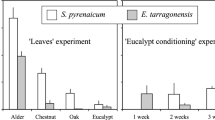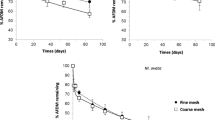Abstract
Shredder feeding is a vital process in making decomposition products available to biota in streams. To investigate which food sources shredders in open-canopy streams exploit, we conducted a feeding preference experiment with the invertebrate detritivores Limnephilus bipunctatus and Nemoura sp., which are commonly found in open-canopy streams on the Swedish island of Öland in the southern Baltic Sea. Leaves of birch, Swedish whitebeam, and shrubby cinquefoil; dead and fresh grass; water moss; and algae were offered to the shredders in multi- and single treatments. We hypothesized that food with high nutritional value would be preferred. Both taxa preferred leaves of shrubby cinquefoil, a bush common in the riparian zone of Öland streams; additionally Nemoura sp. also chose algae. Dead grass, the most abundant food source in the streams during the whole year, was the least consumed food type. The fresh food types had highest nutritional value, measured as carbon to nitrogen content. Therefore, food quality could not alone explain the preference of shrubby cinquefoil. However, among the detritus type offered, shrubby cinquefoil had the highest nutritional value. Shrubby cinquefoil may constitute one important energy source to these open-canopy stream ecosystems and may be essential in maintaining an abundant shredder community in these streams. Thus, the results of this study indicate that detrital resources are indeed important in open-canopy stream systems.


Similar content being viewed by others
References
Abelho M, Graça MAS (1996) Effects of eucalyptus afforestation on leaf litter dynamics and macroinvertebrate community structure of streams in central Portugal. Hydrobiol 324:195–204
Anderson NH, Sedell JR (1979) Detritus processing by macroinvertebrates in stream ecosystems. Annu Rev Entomol 24:351–377
Bärlocher F (2005) A primer for statistical analysis. In: Graça MAS, Bärlocher F, Gessner MO (eds) Methods to study litter decomposition: a practical guide. Springer, Dordrecht, pp 313–329
Bjelke U, Herrmann J (2005) Processing of two detritus types by lake-dwelling shredders: species-specific impacts and effects of species richness. J Anim Ecol 74:92–98
Bjelke U, Bohman IM, Herrmann J (2005) Temporal niches of shredders in lake littorals with possible implications on ecosystem functioning. Aquat Ecol 39:41–53
Canhoto C, Graça MAS (1995) Food value of introduced eucalypt leaves for a mediterranean stream detritivore—Tipula lateralis. Freshw Biol 34:209–214
Chapman DW, Demory RL (1963) Seasonal-changes in food ingested by aquatic insect larvae and nymphs in 2 Oregon streams. Ecology 44:140–146
Chaves ML, Rieradevall M, Chainho P, Costa JL, Costa MJ, Prat N (2008) Macroinvertebrate communities of non-glacial high altitude intermittent streams. Freshw Biol 53:55–76
Covich AP, Palmer MA, Crowl TA (1999) The role of benthic invertebrate species in freshwater ecosystems—zoobenthic species influence energy flows and nutrient cycling. Bioscience 49:119–127
Cummins KW, Petersen RC, Howard FO, Wuyckeck JC, Holt VI (1973) The utilization of leaf litter by stream detritivores. Ecology 54:336–345
Cummins KW, Wilzbach MA, Gates DM, Perry JB, Taliferro WB (1989) Shredders and riparian vegetation—leaf litter that falls into streams influences communities of stream invertebrates. Bioscience 39:24–30
Delong MD, Brusven MA (1998) Macroinvertebrate community structure along the longitudinal gradient of an agriculturally impacted stream. Environ Manage 22:445–457
Fisher SG, Likens GE (1973) Energy flow in Bear Brook, New Hampshire—integrative approach to stream ecosystem metabolism. Ecol Monogr 43:421–439
Franken RJM, Gardeniers JJP, Peeters E (2007) Secondary production of Gammarus pulex Linnaeus in small temperate streams that differ in riparian canopy cover. Fund Appl Limnol 168:211–219
Friberg N, Jacobsen D (1994) Feeding plasticity of 2 detritivore-shredders. Freshw Biol 32:133–142
Gessner MO (2000) Breakdown and nutrient dynamics of submerged phragmites shoots in the littoral zone of a temperate hardwater lake. Aquat Bot 66:9–20
Gessner MO, Chauvet E, Dobson M (1999) A perspective on leaf litter breakdown in streams. Oikos 85:377–384
Gonzalez JM, Graça MAS (2003) Conversion of leaf litter to secondary production by a shredding caddis-fly. Freshw Biol 48:1578–1592
Graça MAS (2001) The role of invertebrates on leaf litter decomposition in streams—a review. Int Rev Hydrobiol 86:383–393
Hladyz S, Gessner MO, Giller PS, Pozo J, Woodward G (2009) Resource quality and stoichiometric constraints on stream ecosystem functioning. Freshw Biol 54:957–970
Inkley MD, Wissinger SA, Baros BL (2008) Effects of drying regime on microbial colonization and shredder preference in seasonal woodland wetlands. Freshw Biol 53:435–445
Irons JG, Oswood MW, Bryant JP (1988) Consumption of leaf detritus by a stream shredder—influence of tree species and nutrient status. Hydrobiol 160:53–61
Lieske R, Zwick P (2007) Food preference, growth and maturation of Nemurella pictetii (Plecoptera: Nemouridae). Freshw Biol 52:1187–1197
Mackay WP, Zak J, Whitford WG (1992) Litter decomposition in a Chihuahuan desert playa. Am Midl Natur 128:89–94
Matthews WJ (1988) North-American prairie streams as systems for ecological study. J N Am Benthol Soc 7:387–409
Menninger HL, Palmer MA (2007) Herbs and grasses as an allochthonous resource in open-canopy headwater streams. Freshw Biol 52:1689–1699
Mihuc TB, Mihuc JR (1995) Trophic ecology of 5 shredders in a rocky-mountain stream. J Freshw Ecol 10:209–216
Monakov AV (2003) Feeding of freshwater invertebrates. Kenobi Productions, Ghent
Pozo J, Basaguren A, Elosegui A, Molinero J, Fabre E, Chauvet E (1998) Afforestation with Eucalyptus globulus and leaf litter decomposition in streams of northern Spain. Hydrobiol 373(374):101–109
R Development Core Team (2009) R: a language and environment for statistical computing. R Foundation for Statistical Computing, Vienna
Richardson JS (1991) Seasonal food limitation of detritivores in a montane stream—an experimental test. Ecology 72:873–887
Solem JO, Gullefors B (1996) Trichoptera, caddisflies. In: Nilsson A (ed) The aquatic insects of North Europe. Apollo Books Aps, Stenstrup, pp 223–256
Sterner RW, Elser JJ (2002) Ecological stoichiometry: the biology of elements from molecules to the biosphere. Princeton University Press, Princeton
Underwood AJ, Chapman MG, Crowe TP (2004) Identifying and understanding ecological preferences for habitat or prey. J Exp Mar Biol Ecol 300:161–187
Vannote RL, Minshall GW, Cummins KW, Sedell JR, Cushing CE (1980) The river continuum concept. Can J Fish Aquat Sci 37:130–137
Wallace JB, Webster JR, Cuffney TF (1982) Stream detritus dynamics regulation by invertebrate consumers. Oecologia 53:197–200
Wallace JB, Eggert SL, Meyer JL, Webster JR (1997) Multiple trophic levels of a forest stream linked to terrestrial litter inputs. Science 277:102–104
Wallace JB, Eggert SL, Meyer JL, Webster JR (1999) Effects of resource limitation on a detrital-based ecosystem. Ecol Monogr 69:409–442
Wallace ID, Wallace B, Philipson GN (2003) A key to the case-bearing caddis larvae of Britain and Ireland. The Freshwater Biological Association, Ambleside
Welch BL (1951) On the comparison of several mean values: an alternative approach. Biometrika 38:330–336
Williams DD (2006) The biology of temporary waters. Oxford University Press, New York
Young RG, Huryn AD, Townsend CR (1994) Effects of agricultural-development on processing of tussock leaf-litter in high country New-Zealand streams. Freshw Biol 32:413–427
Acknowledgments
We thank Mats Iversjö for help with sorting of CPOM samples and Christina Esplund for running the CHN analyzer. Thanks also to Jan Herrmann and Patrik Stenroth for valuable comments on earlier drafts of the manuscript and to Peter Travis for language review. Three anonymous referees provided helpful comments on the manuscript. This study was funded by the Faculty Board of Natural Science and Engineering at University of Kalmar.
Author information
Authors and Affiliations
Corresponding author
Rights and permissions
About this article
Cite this article
Leberfinger, K., Bohman, I. Grass, mosses, algae, or leaves? Food preference among shredders from open-canopy streams. Aquat Ecol 44, 195–203 (2010). https://doi.org/10.1007/s10452-009-9268-1
Received:
Accepted:
Published:
Issue Date:
DOI: https://doi.org/10.1007/s10452-009-9268-1




